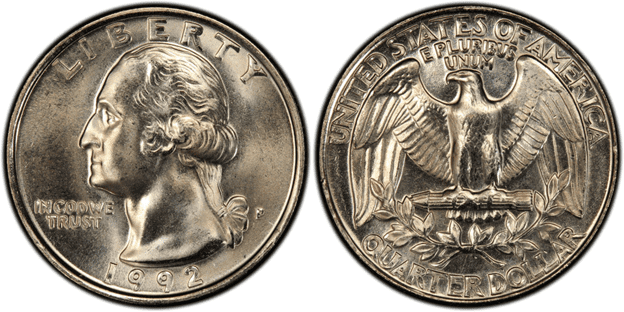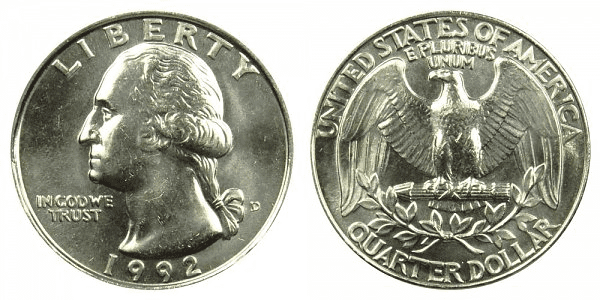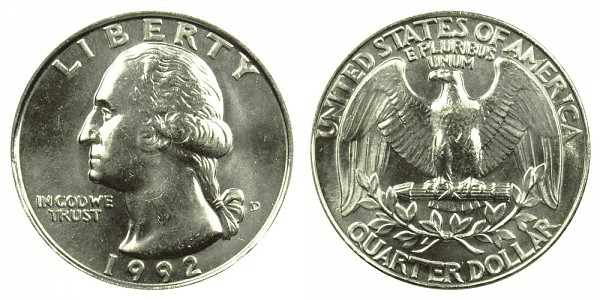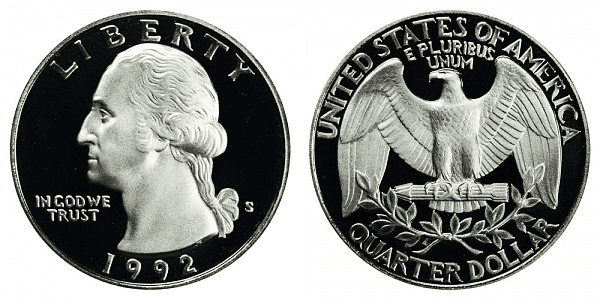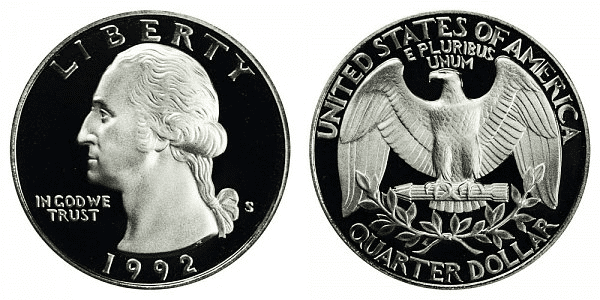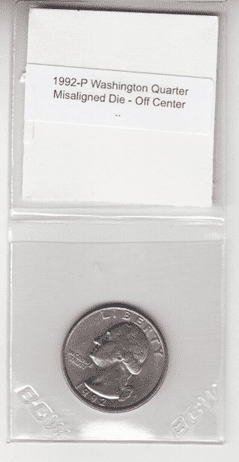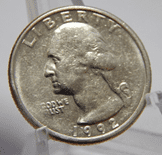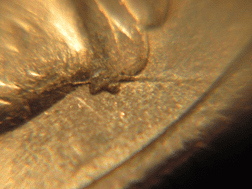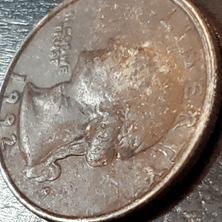What Is the 1992 Washington Quarter Made Of?
The 1992 Washington quarter was made of 91.67% copper and 8.33% nickel. However, there was also a special edition of the 1992 Washington quarter that was mostly made of silver. This is known as the 1992-S Proof Silver Quarter, which was struck in the San Francisco Mint.
Other specifications include the following:
- Value: $0.25
- Diameter: 0.955 in (24.26 mm)
- Thickness: 0.069 in (1.75 mm)
- Mass: 5.67 g
- Edge: 119 reeds
The Washington quarter wasn’t always made of copper and nickel. When it was first released, it was made of 90% silver and 10% copper. This lasted from 1932 to 1964.
In 1964, it was decided to stop producing standard silver coins because people were collecting the coins instead of spending them.

photo source: PCGS
When it comes to design, the 1992 quarter value is the same as other quarters made since 1932. The year 1932 is a special year because it was George Washington’s 200th birthday. As a way of honoring the first president of the United States, congress agreed to add him to the quarter coin.
The sculptor John Flanagan designed the Washington quarter. His original design was used from 1932 to 1998.
The obverse has the left profile of George Washington. Above his head arches the word “LIBERTY.” Below is the year of minting, which is 1992. Below his chin are the words, “IN GOD WE TRUST.” Beside his pigtail is the mint mark, which can be S, D, P, or absent.
On the reverse side, you’ll find the eagle spreading its wings. Above its head is the US motto, E PLURIBUS UNUM. above that are the words, “UNITED STATES OF AMERICA.” Below is the value of the coin in words, “QUARTER DOLLAR.”
The eagle is holding a bundle of arrows that represents the willingness of the US to go to war if necessary. The olive branches symbolize peace.
Just to give you an idea, here are the different types of Washington quarters that were issued in the past:
- 1932-1964 – silver quarter
- 1965-1998 – clad composition quarter
- 1999-2008 – 50 State quarter
- 2009 – DC and US Territories quarters
- 2010-2021 – America the Beautiful quarters
- 2021 – Washington Crossing Delaware
The US Mint announced that in the future, they are going to mint the following:
- 2022-2025 – American women quarters
- 2026 – Semiquincentennial quarters
- 2027-2030 – Youth Sports quarters
1992 Washington Quarter Varieties
There are different Washington quarter varieties produced in 1992. They usually differ based on the place where they are produced. Some other varieties are unique because of the errors they received.
Here are some of the most common varieties of 1992 Washington Quarter varieties:
1992 D Washington Quarter
Year of minting: 1992
Mint Mark: D
Place of minting: Denver
Quantity produced: 389,777,107
Face Value: $0.25 (twenty-five cent)
Price: 25 cents – $19.00 (or more)
Mass: 5.67 grams
Edge: Reeded
Designer: John Flanagan
Composition: 91.67% Copper and 8.33% Nickel
Diameter: 24.3 millimeters
Thickness: 1.75 millimeters

photo source: USA Coin Book
The 1992 D quarter coin has the D mint mark. This means that it was made in the Denver Mint. There are almost 390 million 1992-D Washington coins made. You can sell this coin for up to $19 or more, depending on the condition and rarity of the coin.
1992 P Washington Quarter
Year of minting: 1992
Mint Mark: P or no mint mark
Place of minting: Philadelphia
Quantity produced: 384,764,000
Face Value: $0.25 (twenty-five cent)
Price: 25 cents – $18.00 (or more)
Mass: 5.67 grams
Edge: Reeded
Designer: John Flanagan
Composition: 91.67% Copper and 8.33% Nickel
Diameter: 24.3 millimeters
Thickness: 1.75 millimeters

photo source: USA Coin Book
The 1992-P quarter coin was made in the Philadelphia Mint. There were more than 380 million of these coins produced in 1992. You can sell this coin from $0.25 to $18.
1992 S Washington Quarters
Year of minting: 1992
Mint Mark: S or no mint mark
Place of minting: San Francisco
Quantity produced: 2,858,981
Face Value: $0.25 (twenty-five cent)
Price: 25 cents – $4.52 (or more)
Mass: 5.67 grams
Edge: Reeded
Designer: John Flanagan
Composition: 91.67% Copper and 8.33% Nickel
Diameter: 24.3 millimeters
Thickness: 1.75 millimeters

photo source: USA Coin Book
The San Francisco Mint is specialized in creating proof coins. So, the 1992 S Washington Quarters are proof coins that feature a deeper detail and shinier appearance. Since proof coins are difficult and more meticulous to produce, there are only about 2.8 million of these coins struck in 1992. You can sell a 1992 S Washington quarter for as much as $4.52.
1992 S Washington Quarters (Silver Proof)
Year of minting: 1992
Mint Mark: S or no mint mark
Place of minting: San Francisco
Quantity produced: 1,317,579
Face Value: $0.25 (twenty-five cent)
Price: 25 cents – $9.95 (or more)
Mass: 5.67 grams
Edge: Reeded
Designer: John Flanagan
Composition: 91.67% Copper and 8.33% Nickel
Diameter: 24.3 millimeters
Thickness: 1.75 millimeters

photo source: USA Coin Book
The 1992 silver proof quarter is a commemorative Washington coin. The US mint started to produce these coins from 1992 up until 1998. The silver-proof Washington quarter coin is made of 90% silver and the rest is copper. At the end of 1992, there were more than 1.3 million silver quarter coins produced.
List Of 1992 Washington Quarter Errors
Aside from the standard coins, there are also some Washington quarter errors made in 1992. With millions of coins being made every year, it is not surprising to see that even the 1992 Washington quarters gained some errors.
Errors usually happen due to the deterioration, wear, and tear of the minting equipment. Sometimes, it also happens due to human error. Accidents and malfunctions may also happen.
Here are some of the most common 1992 Washington quarter errors:
Misaligned Die Variety Error Off Center

photo source: eBay
In this coin, you’ll see that the strike was off-center. The coin’s engraved elements were leaning more towards the right side. This error happened as a result of a misaligned die.
Struck Thru Grease

photo source: eBay
This coin was struck through grease. This is the reason that the engraved elements aren’t as pronounced as they should be. Plus, the mint mark is missing due to grease preventing the die from fully getting in contact with the planchet.
Obverse Die Crack Error

photo source: eBay
Because of wear and tear, the die can sometimes crack after multiple times of striking planchets. As a result, you’ll see the crack also engraved on the coin.
Clad plating error

photo source: eBay
As you may know, the 1992 quarter is made of copper core but it is clad with nickel. It is nickel that gives it a shiny finish. In this error, the clad plating didn’t completely cover the coin. As a result, the coin’s surface isn’t shiny. It looks like an old and rusty coin.
How Much Is 1992 Washington Quarter Worth Today?
The 1992 Washington quarter, if it is just the standard variety and is in circulated condition, is just worth as much as its face value — $0.25. Its melt value is just $0.0510.
However, the silver quarter of 1992 has a higher melt value, which is $3.5247. This means that silver 1992 quarters are more valuable than the cupro-nickel varieties.
Even though the value isn’t that much, there are still rare and well-preserved coins that will command a higher value.
Here is a table to help you get an idea of the value of your coin:
| Coin | Condition | Grade | Mintage | Value |
| 1992 D Washington Quarter | Circulated/mint | Not graded | 389,777,107 | $0.25 to $2.00 |
| 1992 D Washington Quarter | Uncirculated/mint | MS-65 | 389,777,107
|
$9-$25 |
| 1992 D Washington Quarter | Uncirculated/mint | MS-66 | 389,777,107 | $50-$72 |
| 1992 D Washington Quarter | Uncirculated/mint | MS-67 | 389,777,107 | $129-$1,763 |
| 1992 P Washington Quarter | Circulated/mint | Not graded | 384,764,000 | $0.25 to $2.00
|
| 1992 P Washington Quarter | Uncirculated/mint | MS-65 | 384,764,000
|
$3-$25 |
| 1992 P Washington Quarter | Uncirculated/mint | MS-66 | 384,764,000
|
$37-$242 |
| 1992 P Washington Quarter | Uncirculated/mint | MS-67 | 384,764,000
|
$70-$600 |
| 1992 S Washington Quarter | Circulated/proof | Not graded | 2,867,787 | $0.30 to $4 |
| 1992 S Washington Quarter | Uncirculated/proof | PR-68 | 2,867,787 | $12 |
| 1992 S Washington Quarter | Uncirculated/proof | PR-69 | 2,867,787 | $8-$22 |
| 1992 S Washington Quarter | Uncirculated/proof | PR-70 | 2,867,787 | $12-$66 |
| 1992 S Washington Quarter (Silver proof) | Uncirculated/Proof | PR-69 | 1,317,579
|
$8-$25 |
| 1992 S Washington Quarter (Silver proof) | Uncirculated/Proof | PR-70 | 1,317,579
|
$21-$88 |
How Does The Grading System Work?
The Sheldon Scale is used by numismatists to provide a numerical value to coins. The Sheldon Scale goes from poor (P-1) to perfect mint state (P-1) (MS-70). Coins were originally evaluated using words to reflect their condition (Good, Fair, Excellent, Etc.). Unfortunately, coin collectors and dealers had different ideas about what each of these terms represent.
Professional numismatists joined together in the 1970s and established CoinGrading standards. These numismatists now assign grades at key places on the seventy-point scale, using the most regularly utilized numeric points in conjunction with the original adjective grade. The following are the most common coin grades:
-
-
- (P-1) Poor – Indistinguishable and probably damaged; if used, must have a date and mintmark; otherwise, rather battered.
- (FR-2) Fair – Nearly smooth, but without the damage that a coin graded Poor often possesses. The coin must have enough detail to be identified.
- (G-4) Fair – Inscriptions have merged into the rims in some areas, and important elements have been mostly erased.
- (VG-8) Very Good- A little weathered, but all of the primary design elements are visible, albeit faintly. There is little if any, central detail left.
- (F-12) Good – The item is very worn, yet the wear is even, and the overall design details stand out clearly. Rims are almost completely isolated from the field.
- (VF-20) Very Fine – Moderately weathered, with some finer features still visible. The motto or all letters of LIBERTY are readable. Both sides of the coin have entire rims that are separated from the field.
- (EF-40) Extremely Fine – Gently used; all gadgets are visible, and the most important ones are bold. The finer details are bold and clear, however, light wear may be seen.
- (AU-50) Uncirculated – Slight evidence of wear on the coin’s design’s high points; may have contact marks; eye appeal should be adequate.
- (AU-58) Uncirculated Choice – Slight traces of wear, no severe contact marks, almost full mint shine, and great eye appeal.
- (MS-60) Mint State Basal – Strictly uncirculated; no indication of wear on the coin’s highest points, but an unsightly coin with reduced luster, visible contact marks, hairlines, and other flaws.
- (MS-63) Mint State Acceptable – Uncirculated, but with contact scratches and nicks, little reduced shine, but otherwise appealing appearance. The strike is weak to average.
- (MS-65) Mint State Choice – Uncirculated with great mint shine, very little contact blemishes, and exceptional eye appeal. The strike is unusually severe.
- (MS-68) Mint State Premium Quality – Uncirculated with superb luster, no obvious contact marks to the naked eye, and exceptional eye appeal. The strike is quick and appealing.
- (MS-69) Almost Perfect Mint State – Uncirculated with perfect brilliance, a sharp and appealing strike, and extremely good eye appeal. A near-perfect coin with minor imperfections in the planchet, strike, and contact markings (seen only under 8x magnification).
- (MS-70) Mint State Perfect – Under 8x magnification, there are no tiny imperfections discernible; the strike is crisp, and the coin is perfectly centered on a beautiful planchet. Rarely seen on a coin, this coin is bright and whole, with original luster and exceptional eye appeal.
-
Are There Any Rare 1992 Washington Quarter?
With millions of 1992 Washington quarter coins, there ain’t a lot of rare coins of this type out there. However, there are coins that are rare by conditions. For example, a coin with a grade of MS-67 and above is considered to be rare because only a few of these coins get this grade.
Just to give you an idea, a 1992-D Washington quarter with an MS-67 grade was sold for $1,763 in an auction held by Heritage Auctions in November 2013.
Where To Buy Or Sell 1992 Washington Quarter?
There are different places where you can buy or sell a 1992 Washington quarter. You can go online and visit websites such as Amazon, eBay, and Etsy. There are also websites that specialize in selling and buying Washington quarters. Some of them include Coin Trackers, USA Coin Book, Grey Sheets, and others.
PCGS and NGC, two of the most respected coin grading service providers, also help enthusiasts find their needed coins. You can also visit their local offices to learn more.
Coin shops, collectors hubs, and auction houses could also be good choices.
Be sure to work with a reputable and trusted seller or buyer. You can always get help from renowned coin service providers to be sure.
FAQs
Is there anything special about the 1992 quarter?
The special thing about 1992 quarters is the silver proof edition. It is not every day that you get a silver issue from the US Mint after the 1965 decision of producing standard coins with base metals.
Does the 1992 D US quarter have a mint “sandwich” error?
The existence of a 1992 D US quarter with a “sandwich mint” error was not fully established. According to forums, the coin might have been created by someone who was trying to make a fake quarter. Yet, others can’t believe that people would do that for only $0.25. Some then concluded that it is a legitimate mint error.
Is the 1992-D Close AM cent worth $20700?
Yes, there was a 1992-D Lincoln cent that was sold for $20,700 during a Heritage Auction sale in July 2012. The AM cent has the legs of the letters A and M in the word America to be closer than usual. This made the coin so rare that it commands a high price for buyers.
How do I know if my 1992 D quarter has a doubled die error?
You can take a look at the engraved elements of the 1992 D quarter for signs of a doubled-die error. If you see a doubling, whether partial or full, it can be considered to be a doubled-die error. If you wish to confirm, you can speak to a professional coin appraiser or grader.

